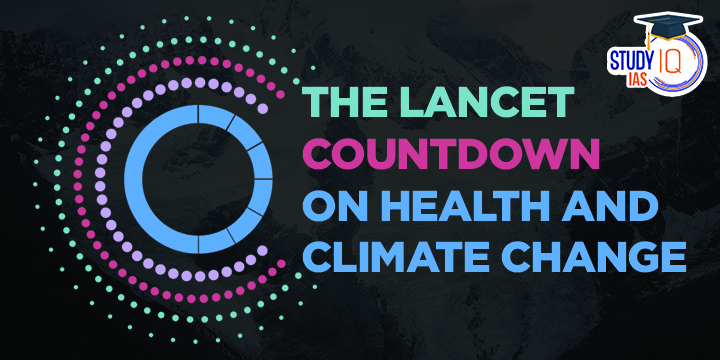Table of Contents
Lancet Countdown on Health and Climate Change 2022 Report
The Lancet Countdown on Health and Climate Change Report represents the work of 99 experts from 51 institutions, including the World Health Organization (WHO) and the World Meteorological Organization (WMO), and is led by University College London.
The Lancet Countdown on Health and Climate Change 2022 Report has 43 indicators to monitor the impact of extreme temperature on food insecurity, household air pollution, and the alignment of fossil fuel industry with a healthy future.
Lancet Countdown on Health and Climate Change Highlights of the Report
- Food Security: Climate change is affecting every pillar of food security.
- The growth season of crops are shortened by 9.3 days for maize, 6 days for winter and spring wheat and 1.7 days for rice.
- On average, 29% more of the global land area was affected by extreme drought annually between 2012–2021, than between 1951–1960.
- Due to extreme heat 98 million more people have reported moderate to severe food insecurity in 103 countries in 2020 than annually between 1981 and 2010.
- Exposure to extreme heat: Vulnerable populations are most at risk from extreme heat
- Compared to 1986–2005, children under one year old experienced collectively 600 million more days of heatwaves, and adults over 65 years 3.1 billion more days in 2012–2021.
- Compared to 2000-2004, the heat related deaths increased by 68% between 2017-2021.
- Heat exposure led to global loss of 470 billion potential labour hours in 2021 with proportionate income losses. This disproportionately affected low- and middle-income countries and worsened the cost-of-living crisis.
- Spread of infectious diseases: The changing climate is also affecting the spread of infectious diseases.
- Since 1951-1960, the length of time suitable for malaria transmission rose by over 32% in highland areas of the Americas, and nearly 15% in Africa in 2012-2021.
- In the same time period, the risk of dengue transmission due to climate influence rose by 12% globally.
- Rising infectious diseases combined with the COVID-19 pandemic has led to misdiagnosis, created pressure on health systems, and difficulties in managing simultaneous disease outbreaks.
- Continued preference to fossil fuels by Industry: Governments and companies continue to prioritise fossil fuels to the detriment of people’s health.
- The carbon intensity of the global energy system (the biggest single contributing sector to global greenhouse gas emissions) has reduced by less than 1% from 1992 levels when the UNFCCC was adopted.
- As per the current strategies of 15 of the largest oil and gas companies, their greenhouse gas production would exceed their share of emissions compatible with 1.5°C of warming by 37% in 2030, and 103% in 2040.
- The current pace of transition towards fully decarbonising the energy system would take 150 years which is far from the actions required for keeping global warming at 1.5°C as agreed in the Paris Agreement.
- Government’s priority towards fossil fuels: Governments continue to encourage fossil fuel production and consumption.
- The report analysed 86 governments out of which 69 are effectively subsidising fossil fuels. The total amount of fossil fuel subsidy comes $400 billion in 2019.
- On the other hand, countries have failed to meet a far less target of climate finance of $100 billion per year to support climate change actions in lower income countries. This was the target to be met by 2020 as committed under the Copenhagen Agreement of UNFCCC.
- Pollution:
- Globally, in 2020, biomass (such as wood or dung) contributed to nearly 31% of energy consumed in the domestic sector, rising to 96% in low- to middle-income countries.
- Household concentrations of particulate matter air pollution (PM2.5) exceed the WHO recommendation by 30-fold in 2020 in 62 countries, exposing families to dangerous levels of air pollution.
Lancet Countdown on Health and Climate Change: India Specific Factsheet
- Taking 1981-2010 as the baseline, the duration of the growth season for maize has decreased by 2%, while the decrease for rice and winter wheat is by 1%.
- Compared to 1986-2021, from 2012-2021, each infant experienced an additional 0.9 heatwave days per year while adults over 65 years age experienced an additional 3.7 heatwave days per person.
- Between the period of 2000-2004 to 2017-2021, heat-related deaths increased by 55% in India.
- Due to heat exposure, India lost 167.2 billion potential labour hours in 2021 with income losses equivalent to about 5.4% of GDP.
- Between 1951-1960 to 2012-2021, the number of months suitable for dengue transmission rose by 1.7%, reaching 5.6 months each year.
Lancet Countdown on Health and Climate Change Recommendations
- Accelerating the transition to clean energy and energy efficiency will prevent further increases in climate change-related death and disease while improving clean energy access and security.
- A health-centred response in current crisis would prompt energy companies rapidly shifting to clean fuels and countries promptly reaching net zero greenhouse gas emissions, thus unlocking a future of sustainable development.
- Improvements in air quality would help to prevent deaths resulting from exposure to fossil fuel-derived particulate matter air pollution.
- Accelerating a transition to more balanced and plant-based diets would not only reduce 55% of agricultural sector emissions from red meat and milk production, but also prevent up to 11.5 million diet-related deaths annually and reduce the risk of zoonotic diseases.
- Urban redesign that puts health first can provide increased greenspace that reduces urban heat, improve air quality, and benefit physical and mental health.


 Micrometeoroids: Tiny Space Particles, M...
Micrometeoroids: Tiny Space Particles, M...
 India Needs a National Insolvency Tribun...
India Needs a National Insolvency Tribun...
 Unlocking the Potential of India–Afric...
Unlocking the Potential of India–Afric...

























